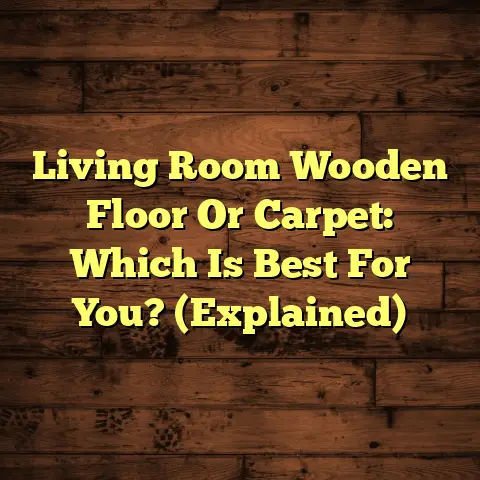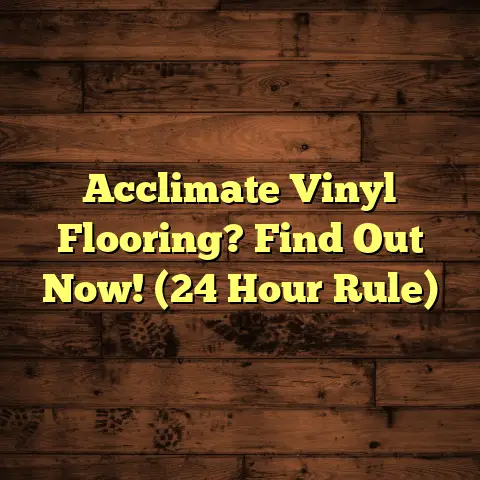Laminate & Rubbing Alcohol? (1 BIG Mistake!)
Being a flooring contractor, I’ve witnessed every kind of flooring mishap.
Trust me, I’ve seen floors that have been through a lot!
Let’s talk about something that can turn a bright cleaning day into a flooring nightmare: rubbing alcohol and laminate floors.
Ever had that moment where you’re cleaning, feeling productive, and then…bam! Disaster strikes?
I’m going to dive deep into why mixing
laminate and rubbing alcohol is a recipe
for disaster.
Let’s get started!
1. Understanding Laminate Flooring
So, what exactly is laminate flooring? It’s not solid wood, that’s for sure.
Laminate is a multi-layer synthetic flooring
product fused together through a lamination
process.
Think of it like a super-durable
sandwich.
- Wear Layer: The top layer, protecting against scratches and stains.
- Decorative Layer: This gives the floor its visual appeal, often mimicking wood or stone.
- Core Board: Made of high-density fiberboard (HDF) or medium-density fiberboard (MDF), providing stability.
- Backing Layer: The bottom layer, providing moisture resistance.
Laminate’s popularity comes from its impressive
durability, affordability, and aesthetic appeal.
It’s tough, budget-friendly, and looks great in
just about any room.
It’s a fantastic option for living rooms,
bedrooms, and even kitchens.
(Though
I’d still recommend tile for bathrooms!)
According to a report by Statista, laminate
flooring accounts for a significant portion
of the flooring market, driven by its cost-effectiveness
and ease of installation.
Did you know that the
global laminate flooring market was valued at
over $30 billion in 2023?
It’s a big deal!
2. The Role of Cleaning in Maintaining Laminate Flooring
Now, let’s talk cleaning. Why is it so important?
Regular cleaning keeps your laminate looking
its best and extends its lifespan.
Dust, dirt,
and spills can scratch the surface and dull the
finish over time.
I always tell my clients, “Prevention is better than cure!” Regular sweeping or vacuuming is key.
Here’s a quick rundown of common laminate cleaning methods:
- Sweeping: Daily or every other day to remove loose dirt.
- Vacuuming: Use a soft brush attachment to avoid scratches.
- Damp Mopping: The most common method, but be careful with water!
- Specialized Cleaners: Products specifically designed for laminate.
Using the right cleaning products is crucial.
Harsh chemicals can damage the protective
layer of your laminate, leading to discoloration
and warping.
Ever seen a floor that looks
“cloudy” after cleaning?
That’s often the
result of using the wrong products.
3. The Rise of Rubbing Alcohol as a Cleaning Solution
Okay, let’s get to the heart of the matter:
rubbing alcohol.
What is it, and why do
people use it for cleaning?
Rubbing alcohol, or isopropyl alcohol, is a
versatile solvent with disinfecting properties.
It’s typically available in concentrations of
70% or 91%.
It’s known for its ability to kill germs,
remove sticky residue, and evaporate quickly.
That’s why it’s a popular choice for cleaning
everything from electronics to bathroom fixtures.
People love it because:
- It’s a disinfectant: Great for killing bacteria and viruses.
- It’s a solvent: Effective at dissolving grease and grime.
- It evaporates quickly: Leaves surfaces dry and streak-free.
But, and this is a big but, just because it’s great for some surfaces doesn’t mean it’s safe for all.
4. The BIG Mistake: Using Rubbing Alcohol on Laminate Flooring
Here’s where things get real.
Using rubbing
alcohol on laminate flooring is a BIG mistake.
Why?
Let’s break it down.
Rubbing alcohol can damage the finish on
laminate flooring.
The alcohol acts as a
solvent, breaking down the protective layer
that gives laminate its shine and durability.
Think of it like this: that protective layer
is your floor’s sunscreen.
Alcohol strips
that sunscreen away, leaving it vulnerable
to damage.
The chemical interaction is pretty straightforward: the alcohol dissolves the acrylic or polyurethane finish on the laminate, leading to dullness, discoloration, and even warping.
I’ve had clients tell me horror stories about using rubbing alcohol on their floors.
One client, Sarah, told me she used a
rubbing alcohol solution to clean up a
sticky spill.
A few days later, she noticed
a dull patch where she had cleaned.
“It looked like someone had taken sandpaper to my floor!” she lamented.
Another client, John, used rubbing alcohol to
“disinfect” his laminate after a party.
He
ended up with a cloudy film that he couldn’t
remove, no matter how hard he tried.
These aren’t isolated incidents. I’ve seen this happen time and time again.
5. Signs of Damage Caused by Rubbing Alcohol
So, how do you know if your laminate has
been damaged by rubbing alcohol?
Here are
some telltale signs:
- Dullness: The floor loses its shine and looks flat.
- Discoloration: Patches of the floor may appear lighter or darker than the surrounding area.
- Warping: The edges of the laminate planks may start to curl up.
- Cracking: In severe cases, the surface may crack.
The long-term effects of using inappropriate
cleaners can be devastating.
The damage
may not be immediately apparent, but over
time, it can lead to costly repairs or even
replacement of the entire floor.
I’ve seen homeowners who tried to save a
few bucks on cleaning products end up spending
thousands on new flooring.
It’s just not worth
the risk.
There’s also a psychological impact.
Your
floors are a big part of your home’s aesthetic.
Damaging them can be incredibly frustrating
and disheartening.
Think about it: you take pride in your home.
You want it to look its best.
Damaged floors
can make your entire house feel less inviting.
6. Expert Opinions on Cleaning Laminate Flooring
What do the experts say?
I’ve consulted
with numerous flooring manufacturers and
industry professionals, and the consensus is clear:
avoid rubbing alcohol on laminate.
Here’s what the pros recommend:
- Use a pH-Neutral Cleaner: These are specifically designed for laminate and won’t damage the finish.
- Damp Mop Only: Avoid soaking the floor with water.
- Follow Manufacturer Instructions: Always read the label on your cleaning products.
Many manufacturers explicitly warn against
using harsh chemicals like bleach, ammonia,
and, yes, rubbing alcohol.
I cannot stress
this enough.
I remember talking to a representative from
Armstrong Flooring, a leading manufacturer.
They told me that using the wrong cleaning
products is one of the most common reasons
for warranty claims being denied.
“We design our floors to withstand everyday wear and tear,” she said, “but they’re not immune to the effects of harsh chemicals.”
7. Alternative Cleaning Solutions for Laminate Flooring
Okay, so rubbing alcohol is a no-go.
What
can you use to clean your laminate floors?
Here are some safe and effective alternatives:
- DIY Solution: Mix a small amount of dish soap (pH-neutral) with warm water.
- Vinegar Solution: Dilute white vinegar with water (1/4 cup vinegar per gallon of water).
- Commercial Laminate Cleaners: Many brands offer products specifically designed for laminate floors.
Always test any new cleaning solution in an inconspicuous area first to ensure it doesn’t damage the finish.
I personally recommend using a microfiber
mop.
They’re great at picking up dirt and
dust without scratching the surface.
Avoid using steam mops.
The heat and moisture
can penetrate the seams and cause warping.
I’ve seen this happen more times than I can count.
8. Preventing Future Mistakes
How can you avoid making the same mistake?
Here are some tips to prevent future flooring
disasters:
- Read Product Labels: Always read the instructions and warnings on cleaning products.
- Create a Cleaning Schedule: Regular cleaning prevents dirt and grime from building up.
- Educate Your Family: Make sure everyone in your household knows how to properly care for your laminate floors.
- Use Doormats: Place doormats at entrances to trap dirt and debris.
- Use Furniture Pads: Protect your floors from scratches caused by furniture.
I always tell my clients to think of their
floors as an investment.
A little bit of
preventative maintenance can go a long way.
9. Conclusion
So, there you have it.
Using rubbing alcohol
on laminate flooring is a big mistake that
can lead to costly damage.
Remember:
- Rubbing alcohol can strip the protective finish.
- It can cause dullness, discoloration, and warping.
- There are plenty of safe and effective alternative cleaning solutions.
I encourage you to adopt safe cleaning practices
and take care of your laminate floors.
With
proper maintenance, they can last for many
years and continue to look beautiful.
Your floors are the foundation of your home.
Treat them with the care they deserve.
And if you’re ever unsure about the best way
to clean your floors, don’t hesitate to consult
with a professional.
I’m always happy to help!





